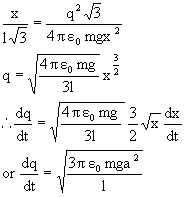Electrostatics - 8
Q-2: Suppose in an insulating medium having dielectric constant K=1, and volume density of positive charge varies with coordinates according to law ![]() . A particle of mass m having positive charge q is placed in the medium at point A (0, y0) and projected with
. A particle of mass m having positive charge q is placed in the medium at point A (0, y0) and projected with![]()
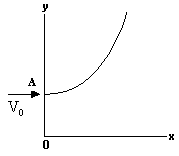
Fig (38)
Neglecting gravity and frictional resistance of the medium and assuming electric field strength to be zero at y=0, Calculate slope of trajectory of the particle as a function of y.
solution: Since, charge density varies with y coordinates only, therefore in medium an electric field exists which is directed along y axis. To calculate this electric field E(y). Consider a thin layer of medium having thickness dy at a distance y from x-axis as shown in figure.
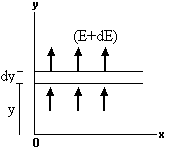
Fig (39)
Let strength of electric field at positions y and (y+dy) be E and (E+dE) respectively.
Then for area A of the layer,
According to Gauss law![]()
![]()
Integrating above equation with limits,
At y=0, E=0 and at y=y, E=E
Since frictional resistance of the medium is negligible, therefore there is no force on particle along x-axis or velocity V0 of particle along x-axis remains constant.
Due to Electric field E, particle accelerates along positive y, this acceleration =![]()
Let y-component of velocity of particle be v![]()
Hence,

But at point A(y=y0) y component of velocity is v=0

Question:
1) Why there is no force in x-direction?
Ans: The applied electric field is in the y-direction only and it has been mentioned in the question that friction, gravity have to be neglected. Thus there is no force in x-direction.
Q-3: Three identically charged, small sphere each of mass m are suspended from a common point by insulated light strings each of length l the spheres are always on vertices of an equilateral triangle of length of the sides x (<<l). Calculate the rate ![]() with which charge on each sphere increases if rate of increase of length of the sides of the equilateral triangle varies as
with which charge on each sphere increases if rate of increase of length of the sides of the equilateral triangle varies as ![]() .
.
solution: Since ![]() is given as
is given as ![]() therefore to calculate
therefore to calculate ![]() first q is to be calculated in terms of x.
first q is to be calculated in terms of x.
Since side of equilateral triangle is x, therefore electrostatic force between two particle is![]()
Positions of particle A, B, C with respect to each other are as shown in figure (40)-A.
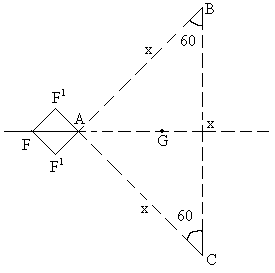
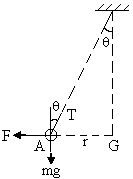
Fig (40)-A Fig (40)-B
Resultant electrostatic force on particle A is
F = 2F1Cos300
![]()
In figure (A) G is centroid of triangle.
Distance of centroid G from every particle is ![]()
Since G is centroid therefore it always lies vertically below the point of suspension.
Fig (B) shows a vertical plane passing through particle A and centroid G. All of the force acting on particle A is shown in figure (B)
Considering horizontal forces on the particle A,
TSin![]() = F ---------- (1)
= F ---------- (1)
For vertical forces TCosq = mg ---------- (2)
Dividing eq (1) by eq (2)![]()
Since x<<l therefore inclination q of each thread with the vertical is very small.
![]()
From equation (3)
